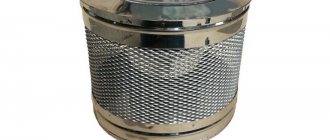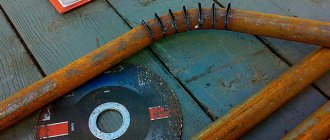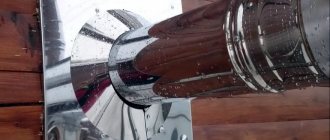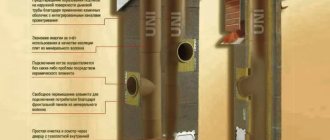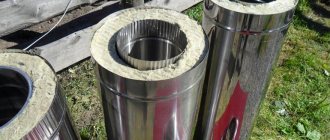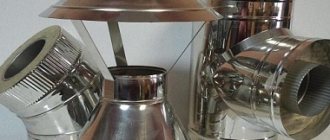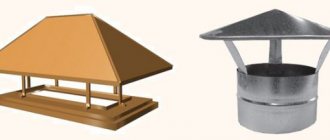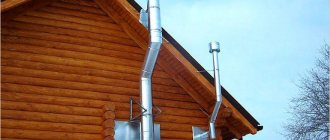Features of installing spark arresters
The most common are spark arresters, which are made in the form of a deflector and have a mesh. They apply in the following cases:
- If the roofing is a material that is easily flammable.
- The spark arrester is installed only on a straight pipe that comes from the boiler, since due to the lack of bends, sparks fly out into the chimney.
- Also, spark arresters can be installed on any stove pipe that runs on solid fuel.
Not only does a spark arrestor prevent roof fires from flying sparks, it also helps keep birds away from the chimney. Even if the risk of sparks hitting flammable materials is minimal, it is worth installing a spark arrester in order to protect yourself from fire.
When creating the described product with your own hands, it is worth remembering that not every material is suitable for such a design. If ferritic steel is used, the structure will quickly become unusable due to wear of its elements. Also, do not use galvanized sheet metal. It is best to choose stainless steel, the thickness of which is 0.5 mm, as the main material for creating a spark arrestor. This material is resistant to corrosion. At the same time, it is easy to weld.
Aluminum zinc can also be used. But it is worth noting that such material cannot be joined by simple welding. Rivets must be used to connect all structural elements. When installing a spark arrester on a chimney, you should make sure that the structure will not be broken by gusts of wind.
When choosing a material, it is necessary to correctly select the cell size of the purchased mesh. If you choose a product with too small cells, they will become clogged with soot, which will require constant cleaning of the spark arrestor. If you choose a mesh that is too large, it will not stop the sparks. It is best to purchase products whose cell size is from 3 to 5 mm.
Do it yourself or order a device?
Custom spark arresters are a fairly common option. If you trust the contractor, you can count on a good service life and complete serviceability. But this does not always happen, especially if the manufacturer decides to save on material.
If you decide to make your own spark arrester, it may take you longer. At the same time, you will be able to fully control the process, from the selection and acquisition of materials to design nuances.
Tips for choosing
When choosing, you should pay attention to the dimensions of the pipeline, the type of construction and the quality of the material. The diameter of the devices is usually 80-550 mm. The dimensions of the canopies depend on the dimensions of the tubular structures that are placed on the chimney.
The most commonly recommended products are stainless steel. Lack of corrosion, durability and affordable price are the main advantages of this solution.
Popular models
There are simplified shell-like options and solutions with a deflector function. Among the latter, the following popular modifications can be distinguished:
- TsAGI;
- Grigorovich's apparatus.
- Round Volper.
- H-shaped device.
- Vane.
- Disc-shaped.
Creating a spark arrester similar to a deflector
It is worth noting that structures created like a deflector are more effective than products with a mesh. Spark arrestors are often created for a brick pipe similar to the Tsaga deflector, to which an apron is added that catches sparks. Creation occurs as follows:
- First you need to cut out a template for the future design from cardboard. If this step is neglected, you may accidentally cut the metal incorrectly, after which you will have to use a new sheet of this material. Also at this stage the pipe diameter is measured.
- The internal part of the spark arrestor is created from a pipe, the diameter of which must be such that it can be placed on the chimney.
- It is worth noting that the diameter of the upper edge of the sleeve being created should be larger than that of the lower one. To do this, you need to roll out the edge of the finished product.
- The casing is created from a piece of pipe. You need to know that its diameter must be larger than the diameter of the sleeve. The casing is secured to the sleeve using metal plates.
- The apron is attached approximately 60 cm below the casing. It is worth remembering that the size of the apron must be larger than the diameter of the casing being created. If this is not taken into account, sparks will fly past the structural element being described.
- The next step is to install the cover. It is fixed above the top of the casing. All parts are connected with rivets, for which holes are first drilled.
- At the last stage, the spark arrester is fixed to the pipe. During this work, it is important to check the reliability of the connection so that in a strong wind the structure will not be torn off.
By creating even a simple spark arrester, you can make your bathhouse safer.
Step-by-step construction of a spark arrestor
To assemble a spark extinguishing device yourself, you will need simple materials, tools and a couple of hours of free time. Moreover, you can choose the optimal model, shape and size. And the choice of material is unlimited - the quality of the final device will be an order of magnitude higher than that of a purchased one.
Selection of model and materials
First you need to decide which model will serve as a spark arrestor. The consumption of materials, the necessary tools and the time spent to manufacture the device will depend on this.
When you need to make a spark arrester with deflector functions, you need:
- take measurements from the inner surface of the chimney - diameter;
- prepare stainless steel metal sheets, pipes;
- if necessary, buy a metal mesh with the required cells;
- prepare tools - metal scissors, grinder, drill, pliers, hammer, pencil, compass, riveter, ruler, paper;
- purchase a metal clamp of the required diameter and rivets.
If you have a rolling machine, the product will turn out almost like a factory one. Otherwise, don’t be upset - all the work can be done with a hammer.
Also, if you don’t have a riveter, you can use a welding machine. The main thing is not to burn unnecessary holes in the process of connecting the joints.
When choosing a material, preference should be given to stainless steel sheets. Moreover, they can be solid or perforated, which can be used instead of metal mesh. The sheet thickness should not exceed 5 mm - thicker material will be difficult to work with.
It is also better to take a metal mesh from stainless steel, giving preference to one with a cell size of 4-5 mm. Larger openings are not as effective at stopping sparks, and openings that are too small can prevent gases and smoke from moving freely.
Making a spark arrester prototype
When the model of the spark arrester has been selected, you can begin to draw it on paper according to pre-taken measurements. For this you will need a sheet of paper, a compass, a pencil, and a ruler. It is important to do everything in full size and carefully - this will later be used as a prototype of the finished product.
When all the details are drawn on paper, you should add 1-2 cm along the edges - these are allowances for connecting the parts of the parts together.
Afterwards, you need to cut out the paper prototype with scissors and assemble everything - this will allow you to evaluate the appearance of the future product. It is at this stage that adjustments can be made. If everything suits you and the pipe diameter is suitable, then you can begin to outline these parts on metal material.
Assembling the product yourself
After sketching, the necessary parts from which the spark arrester will be assembled should be carefully cut out with metal scissors. This will most likely be an umbrella, stainless steel umbrella holder strips, a mesh cylinder, and a piece of metal pipe of the required diameter.
If you forgot to buy a pipe, you can cut out the required part from a solid sheet of stainless steel and assemble it using a rivet mechanism with rivets.
Then you have to assemble all the parts one by one and fasten them together using a riveter. If you don’t have such a tool, you can use a welding machine to make the connection. In this case, seam allowances will be required less than 2 cm, and in order for the seam to have an attractive appearance, it will have to be additionally processed with a grinder.
When assembling a spark arrester, it is important to take into account the features of a particular model. If it is just a spark arrester without a deflector function, then there should be no gaps between the parts - all sparks flying out of the chimney must encounter an obstacle in their path.
When assembling a spark absorber with a deflector function, you first need to build the deflector itself. Afterwards, in the lower part of the base, at a distance of 6 cm from the lower edge of the upper glass, make holes with a drill for connection with the skirt.
The part is made from a stainless steel sheet in the shape of a plate with raised outer edges.
Sometimes home craftsmen, instead of building a spark extinguisher, improve the chimney.
The types of manipulations depend on the type and shape of the pipe:
- holes are made in the metal one in the upper part, and the head is completely covered with a solid stainless steel lid;
- if the chimney is square, then simply attach a metal mesh on top;
- reduce the draft slightly by closing the valve to reduce sparking.
The first option is the most labor-intensive. And the holes will still become clogged with soot over time and will require cleaning. Therefore, it is better to choose an option in which the spark arrester can be easily removed.
Installing and securing the device
When the work on assembling the spark arrester is completed, the last stage lies ahead - installing it on the chimney. To do this, you will need to climb onto the roof, and if the height of the pipe is quite large, then you will need to invite an assistant.
For installation you will need a rivet mechanism or a metal clamp. Sometimes you can find advice from craftsmen who suggest not to fool your head and simply weld a spark arrester to the chimney pipe. This is bad advice - according to fire safety rules, this structural element must be removable.
Therefore, it is best to use a clamp of the required diameter, which will help securely secure the spark arrester to the chimney pipe.
If rivets are used during installation, then holes are made in advance at the required distance on the pipe and on the spark arrester itself. Then the product itself is put on the chimney and the rivets are placed using a riveter. It's good that they are made of stainless steel. This will extend the service life.
Creating a spark arrester similar to a deflector
It is worth noting that structures created like a deflector are more effective than products with a mesh. Spark arrestors are often created for a brick pipe similar to the Tsaga deflector, to which an apron is added that catches sparks. Creation occurs as follows:
- First you need to cut out a template for the future design from cardboard. If this step is neglected, you may accidentally cut the metal incorrectly, after which you will have to use a new sheet of this material. Also at this stage the pipe diameter is measured.
- The internal part of the spark arrestor is created from a pipe, the diameter of which must be such that it can be placed on the chimney.
- It is worth noting that the diameter of the upper edge of the sleeve being created should be larger than that of the lower one. To do this, you need to roll out the edge of the finished product.
- The casing is created from a piece of pipe. You need to know that its diameter must be larger than the diameter of the sleeve. The casing is secured to the sleeve using metal plates.
- The apron is attached approximately 60 cm below the casing. It is worth remembering that the size of the apron must be larger than the diameter of the casing being created. If this is not taken into account, sparks will fly past the structural element being described.
- The next step is to install the cover. It is fixed above the top of the casing. All parts are connected with rivets, for which holes are first drilled.
- At the last stage, the spark arrester is fixed to the pipe. During this work, it is important to check the reliability of the connection so that in a strong wind the structure will not be torn off.
By creating even a simple spark arrester, you can make your bathhouse safer.
READ Plastering at what temperature can be done
Maintenance of spark arresting systems
Like any simple mechanism, the spark arrester requires routine maintenance, which consists of the following:
- Inspection of the integrity of the entire structure. At least once a year.
- Cleaning the main components and assemblies from soot and other deposits. Twice a year.
- Unscheduled inspection and cleaning. For example, in areas with an abundance of common poplar, the fluff of this tree is able to clog the spark arrester mesh to a dense fiber state. In addition to deteriorating traction, such a nozzle is also a fire hazard. Such work must be carried out as an objective need arises and is not regulated by specific deadlines.
Systems made of ferrous metal under conditions of different temperature loads and condensation formation have a tendency to increased corrosion, which predetermines closer service attention to them than in relation to systems made of stainless steel.
Sparks from a sauna pipe: what to do
The spark arrester does its job as long as the sauna chimney is functioning properly. Violation of the smoke circulation rate leads to flying . The first step is to figure out where they come from. Sparks are small particles of fuel that have not had time to burn in the firebox. With normal draft, they have time to burn out in the stove, and some of them smolder inside the pipe on the way to the exit from the chimney.
As the smoke flow decreases, the fire in the firebox goes out. If the craving is higher than normal, the opposite effect occurs. The fuel flares up quickly and crumbles into particles, which do not all have time to burn. A strong draft of air flow picks up these particles along with the smoke and throws them out through the pipe into the street in the form of a bunch of sparks.
The problem of sparks escaping is inherent in a direct-flow pipe, which is the only drawback of this chimney design. The fire from the firebox immediately enters the vertical pipe. If the chimney channel of a bathhouse has elbows, bends, or horizontal sections, the smoke circulation weakens. Even with strong draft, sparks hit the pipe walls at turns, scatter into smaller parts and manage to burn out before they fly out. However, curved chimneys become clogged with soot faster. For a bathhouse with knees, a pipe is not the best option.
The problem is solved by reducing the smoke circulation rate of the direct-flow pipe. The draft is regulated by dampers, dampers, and the blower door. If positive results cannot be achieved, increase the residence time of smoke and sparks in the chimney by increasing the length of the chimney channel. After the draft is normalized, the spark arrester catches the rarely emitted sparks.
Reducing the smoke circulation below the norm leads to the contamination of the bath with carbon monoxide, which is deadly to humans.
Advantages and disadvantages
Speaking about the advantages common to all designs, it is worth noting the unimpeded exit of smoke from the pipeline and the preservation of the original draft. In the case of spark arresters-deflectors, the thrust indicator increases.
The option in the form of a casing or mesh cap is characterized by the simplest and cheapest assembly scheme, as well as the simplest installation.
There are some shortcomings here. For example, this type does not have a deflector umbrella, which prevents precipitation from entering the chimney. The second flaw of such a spark arrester is the absence of a partition that changes the movement of gases along the axis.
How to make a spark arrester for a bathhouse pipe - possible design options
A spark arrester is a device installed on the chimney of a bathhouse to prevent the emission of sparks that appear during the combustion of solid fuel. The design of the spark arrester is quite simple, so you can make it yourself. How to make a spark arrestor for a bathhouse with your own hands will be discussed in this article.
Making a spark arrester prototype
After removing the internal and external diameters of the bath pipe, we begin making a paper prototype. Elements of the drawing are transferred to cardboard. At the joining points, leave an allowance of about 2 cm. The width of the seam should be enough for the hole for the rivet.
The lined fragments of the head are cut out of cardboard. It must be elastic, otherwise creases will appear when bent. Temporarily the parts are connected with a stationery stapler. The finished prototype of the spark arrester should be life-size and put on the bathhouse pipe.
If the template is satisfactory in all respects, it is disassembled. The paper clips are carefully unbent at the joints, removed, the fragments of the head are straightened, placed on stainless steel, and outlined with a marker. A pencil will not work for marking, as it is hard to see on the steel.
Stages of manufacturing a spark arrestor
To make a spark arrester for a brick pipe, the following tools and materials are needed:
- stainless steel sheet, the thickness of which should be in the range from 0.5 to 1 cm;
- metal mesh with high rigidity;
- steel rivets necessary to connect some structural elements;
- metal scissors;
- Bulgarian;
- welding machine.
It is worth remembering that if sparks periodically fly from the pipe, then you should not install a simple visor on it. Such devices are not able to stop flying sparks. To save money, you can not buy ready-made products, but make them yourself, because this does not require experience in performing such work.
The simplest design is made as follows:
- First you need to purchase a metal mesh. It is important to choose a rigid material, since it does not deform when exposed to high temperatures.
- After this, you need to prepare a piece of metal pipe.
- Then a rectangle is cut out of the mesh, the length of which is equal to the diameter of the pipe.
- After this, you need to wrap the pipe with mesh and secure it by welding. At this stage, it is important to securely fasten the mesh so that it can withstand strong winds.
- At the next stage, the cone is secured over the mesh. The fastening takes place on metal brackets so that there is a small distance between the mesh and the cone.
- At the final stage, the finished spark arrester is fixed to the pipe using metal brackets.
Sparks fly from the chimney in the bathhouse. The installed spark arrester does not help. I am worried about the fire safety of the bathhouse, since sparks fly very strongly, especially when the firebox door is open. I heat with wood, pipe with a diameter of 110 mm, a length of 4.5 meters, welded from a gas pipe with a diameter of 42 cm. I cut this pipe in half and welded both halves to each other.
Quite a serious problem. Sparks can cause fires on wooden walls and floors. Sparks can ignite various coatings.
straight-through pipe is dangerous, especially when there is a strong draft in it. This problem can be solved by making a smoke circulation, which will reduce the speed at which smoke flies out into the chimney. There are several ways to do this.
Perhaps your firebox and ash door do not close tightly and there is no damper. Thus, the penetrating air helps to ignite the coals. That is, in this case, you need to think about some changes in the design of the furnace, and not about how to catch flying sparks. And the operation of the furnace itself needs to be monitored. Without the skills to light a stove, it will not be so easy to cope with the task. One thing is certain: the fewer twists and turns, the better the smoke circulation will be. Accordingly, the fire will burn better and there will be fewer sparks. After all, sparks are nothing more than an unburned fire rushing out. It is prevented from igniting by a large amount of smoke and a large amount of sharply supplied oxygen.
READ How to remove super glue from skin
So, you need to try to change the speed of gas circulation in the pipe, but so that the draft remains sufficient, otherwise you may get burned. That is, if the burned oxygen does not find a way out, it will begin to penetrate into all sorts of cracks and seep into the room. The effect of carbon monoxide is such that a person does not immediately notice its presence. This is why gas is insidious. To ensure safe use of the oven, you can follow these steps: It is also possible to increase the residence time of gases in the pipe due to additional smoke circulation. But it is not so easy to say something more precisely about your problem. It is necessary to have more detailed information about the operation of the furnace. How can you judge a problem without a drawing in hand? An additional smoke circulation device is most likely preferable here; in addition, it will help you get additional heat for your steam room, which at the moment, along with smoke and sparks, simply flies into the chimney.
Step-by-step manufacturing instructions
To manufacture a spark arrester, you will need certain mechanical skills, as well as the ability to choose a product design that is suitable for the given conditions.
Design selection
When considering various options for a spark arrestor for a chimney, you should pay attention to a stainless steel product in combination with a classic n-shaped deflector. Also, one should not exclude the possibility of independently manufacturing a special type of deflector, equipped with a skirt for extinguishing spark formations
Preparatory activities
After choosing the type of spark arrestor, you should prepare everything necessary for its independent manufacture, including the following set of tools and materials:
- an ordinary hammer, pliers, as well as small clamps and a set of screwdrivers;
- linear measuring instruments;
- scissors for cutting metal, a grinder and a drill with a set of drills;
- household welding unit and a set of rivet devices.
The most convenient material for assembling the system is stainless steel, which has all the necessary protective qualities. The diameter of the rods from which mesh structures are mounted should be as minimal as possible (no more than 4 mm). But they should also not be made too thin, since in this case they can quickly burn out from the heat.
Before starting work, you should measure the dimensions of the existing chimney, on the basis of which sketches of the future protective device are then drawn up. For these purposes, it is most convenient to use cardboard blanks, used as a kind of stencil.
Based on the obtained sketches, a drawing of the future device should be prepared, which should indicate the exact dimensions of all its constituent elements.
Product assembly
In order to assemble a spark arrestor with your own hands, you must follow certain rules. Elements of a mesh fence for the chimney can be purchased ready-made in the store or made independently (rods with a diameter ranging from 1 to 6 mm are suitable for these purposes).
To connect individual components of a homemade spark arrester, it is most convenient to use manual welding, after which the resulting seams are thoroughly cleaned.
The final fastening of all structural elements is carried out using previously prepared rivets.
When using the option of combining a spark arrester with a deflector, a visor of the required size is first cut from metal sheet blanks of a certain thickness.
Then a large number of holes are drilled in it, sufficient for the free flow of exhaust gases. After this, the resulting workpiece is bent at the required angle, and the bending zones are additionally fixed using metal rivets.
How to make a spark arrester for a pipe with your own hands
When sparks fly from a sauna pipe, the first thing to do is install a spark arrester. For some, purchasing this item may not be affordable, or it may be difficult to select a model in the right size. Thus, making a spark arrestor yourself turns out to be much easier.
Of course, the first thing to do is to be patient and carefully take all measurements.
- A complete measurement of the outlet of the chimney pipe, after which a sketch drawing of future parts of the protective element is made;
- Next, cardboard sketches are applied to the sheet of metal and finished parts are cut out. It is very important to monitor accuracy, since the part must completely correspond to the sketch;
- To make a spark arrestor, you can use part of a finished mesh or make it yourself using metal rods;
- Each of the joints must be connected using a welding machine, after which they must be thoroughly cleaned with a grinder;
- Secure each of the spark arrester parts with metal rivets;
- The completely finished protective structure must be installed on the chimney pipe, carefully secured;
- The deflector is made of a sheet of metal, which is rolled into a cone and fastened with metal rivets. The deflector is also attached to the base of the spark arrestor using metal rivets.
In order to no longer ask yourself the question of why sparks are flying from the sauna pipe, you need to take care of installing a high-quality and functioning spark arrester.
Causes of excessive heating of the chimney pipe
Quite often it happens that the chimney pipe heats up to incredibly high temperatures.
This entails danger, since the risk of fire increases several times!
In order to minimize it, you first need to isolate all combustible elements nearby.
be done without fail, since without a high-quality thermal insulation layer around the chimney, you risk your life and health every day.
So, let's look at the main reasons for the problem:
- The chimney is made of a single-walled metal pipe without a heat insulator, which is completely unacceptable. It is imperative to replace single-layer chimney sections with sandwich pipes, or simply supplement them with a heat-insulating layer;
- There may be errors in the design of the sandwich pipe. It should be remembered that this design is installed in such a way that condensation formed inside cannot reach the outer surface of the chimney.
Why do you need a spark arrestor for a chimney | Fornax.
Lead and zinc white
The most important of them are lead and zinc white. In terms of chemical composition, lead white is a basic carbon dioxide salt. Pure white is called solid and is marked No. 0. White with an admixture of barite sulfate (heavy spar) is called graded and is marked No. 1, No. 2 and No. 3. The last two grades sometimes contain up to 40% heavy spar.
When painting with oil, the primer is usually filled with lead white and then covered with zinc.
In terms of its chemical composition, zinc white is zinc oxide. In trade, the highest grade of zinc white is called Schnweiss and is marked No. 0; zincweiss - No. 1.
From lower grades and a by-product of the production of zinc white, zinc gray paint is obtained.
Sparks are flying from the sauna pipe, what should I do?
It’s easy to make a spark arrester for a bathhouse pipe with your own hands, if you have a drawing, a metal mesh and sheet steel. The head is given the shape of a chimney: a circle or a rectangle. However, no spark arrester will help if you heat the stove in the bathhouse incorrectly. Most head models protect only from a small amount of sparks flying out with smoke.
Installing and securing the device
When the spark arrester is ready, all that remains is to climb onto the roof of the bathhouse and install it. The head is placed on the pipe. To prevent it from being blown away by the wind, fix it. The lower part of the head is pressed to the round pipe of the bath with a clamp. The method is reliable and convenient. It is always easy to release the clamp to remove the spark arrestor for cleaning.
To fix it to a rectangular pipe, use a homemade rim with brackets. Another fixation option involves the use of rivets. The head is held securely on the pipe. However, if maintenance is necessary, the rivets will have to be cut off with a grinder, which is extremely inconvenient. The last option is to weld a spark arrestor to a metal sauna pipe. Bad idea. For maintenance, you will have to cut the head off the pipe with a grinder each time.
More information about making a deflector for a bath pipe can be found in
The structure and principle of operation of the spark arrester
The spark arrester device of different models has distinctive design elements. The appearance varies. The common feature is the presence of a housing, a spark-extinguishing element made of steel mesh or sheet, as well as a cover that delays the emission of sparks.
Spark arrester for chimney
All models of spark arresters work on the same principle:
- After the sauna stove is ignited, hot combustion products are formed inside the firebox, consisting of gas, smoke, air, and small particles of unburned fuel. The draft air flow directs them through the chimney of the bathhouse to the street.
- At the top of the pipe, hot air collides with the tip. The smoke escapes unhindered into the atmosphere, and particles of burning fuel strike the extinguishing element made of mesh or sheet metal, the housing, or the deflector cover.
- spark hitting a metal element loses its heat capacity and quickly dies out.
READ The wooden floor in the house is creaking, what to do?
The spark arrester most often traps large fuel particles. Small sparks sometimes slip through. If sparks fly strongly from the sauna pipe, you need to reduce the draft by closing the dampers. Another reason could be burnout of the spark-extinguishing mesh.
A spark arrester on your chimney will save your life and property.
Types of devices for extinguishing sparks
Spark arrestors come in different shapes and sizes. And the element itself responsible for extinguishing sparks is different. Moreover, you can buy a ready-made spark arrester for the chimney in the store or make it yourself. It all depends on skill and personal desire.
You can buy a ready-made spark arrester for installation on a chimney, choosing the most attractive model. Fortunately, manufacturers offer a variety of options, differing not only in appearance, but also in price.
Moreover, the better the performance of the material used in the manufacture of the device, the more expensive its cost will be.
The most commonly used spark arresters are:
- a cap made of metal mesh on the head of the pipe;
- deflector with metal mesh;
- deflector with a skirt for extinguishing sparks.
These are the most popular options for spark arresters, which are easy to build with your own hands if you wish. And a simple structure will be beneficial when making a product yourself. You just need to prepare properly and make preliminary measurements.
A variety of solutions for extinguishing sparks allows you to choose the most suitable option for your chimney. Moreover, not only in appearance, but also in price, which is an important factor when choosing a model.
Protecting the wall from overheating
During operation of a sauna stove, its surface temperature can reach 400 degrees and above.
In addition, it emits infrared rays, heating the walls of the room, especially those closest to it.
If the wall decoration is made of wood, then its constant overheating can lead to charring and fire.
To prevent this, special fire-retardant compounds are used, and for greater reliability, a protective screen is installed for the stove in the bathhouse. The most popular materials for its manufacture:
- Metal. Insulation of walls in a bathhouse from the stove is most often done using a metal screen. They are mainly frontal or lateral. Metal screens significantly reduce the temperature impact on the walls;
- Brick. Brick protective screens can both reduce radiation from the stove in the bathhouse and protect walls from prolonged exposure to high temperatures. Brick for sauna stoves has been used for a long time because it takes a long time to heat up, then gives off soft heat to the room, cooling down for a long time;
- Stainless steel sheets. This material is used to cover both the furnace and surrounding elements. If a stainless steel sheet is thoroughly polished, its mirror surface will reflect harmful infrared radiation.
How does a spark arrester work on a chimney?
The bath pipe is protected from sparks by means of a spark arrester. It is a fairly simple, but effective design. To put it simply, a spark arrester is simply a chimney nozzle with a mesh on the sides and a protective cone on top.
The key features of this mechanism include:
- Installation is permissible on chimney pipes of any type that are powered by a solid fuel stove. The size of the cells that make up the mesh in this case should not exceed 5 mm;
- A do-it-yourself spark arrester on a chimney for a bathhouse must be installed if the roofing material is not fire-resistant enough;
- This mechanism should also be installed on the chimney of the bathhouse if it is equipped with equipment that maintains high temperatures, and the chimney pipe has a very strong draft;
- The mesh, which is part of the spark arrester, needs to be thoroughly and regularly cleaned. If coniferous species are used as firewood, then cleaning is done twice as often.
There are many different elements that differ in shape, design and type of material, but the principle of operation remains the same for all:
- When a stove is fired, the fuel used burns, producing gas and smoke that rushes up the chimney;
- Directly at the exit from the chimney, the trajectory of the smoke changes, since an obstacle in the form of a protective cap is encountered on the way;
- The sparks that have not yet been extinguished are forced to pass through the mesh, which extinguishes them.
The simplest spark arrester can be made independently without any problems, thereby significantly reducing material costs.
Selection of model and materials
When choosing a model of a cap for the chimney pipe of a bathhouse, you should once again carefully think about its effectiveness. A conventional casing is simple, but it only catches sparks and is not able to improve traction. It is better to equip the bath pipe with a deflector. Which option to choose is up to the owner of the bathhouse to decide.
Before production begins, the material is purchased. For any spark arrestor you will need sheet steel. Galvanized is suitable, but stainless steel is better. You also need a mesh with small cells.
Tools for assembling a steel structure you will need:
- metal scissors;
- hammer;
- electric drill;
- chisel;
- pliers;
- rivet gun.
In order not to make mistakes with the calculations, a prototype is first made from paper - an exact copy of the spark arrester. You will need the following materials and tools:
- thick elastic cardboard;
- office stapler;
- paper scissors;
- pencil;
- ruler;
- compass.
If the choice fell on a head with a deflector, in addition to the outer thickness of the bath chimney, measure the diameter of the pipe from the inside. They put their dimensions on the sheet with the drawing.
They think in advance about how to fix the steel elements of the spark arrestor. The best option is rivets. In the absence of a riveter, the fragments are connected by welding. The ability to weld thin metal is important here. If you burn a hole in the housing, sparks will burst out.
The effectiveness and long service life of a spark arrestor depends on the quality of the material. Stainless steel sheets and mesh are used with a thickness of about 1 mm. Thick metal is difficult to work with.
The mesh can be perforated sheet steel. In any case, material with holes of 4-5 mm is suitable. Sparks will freely escape through large cells. Small cells will clog faster, and in addition, draft through the pipe will worsen.
Sources:
https://www.poparimsya.com/pomosch-experta/voprosy-osnawenie/iskry-iz-truby-bani.html https://znai-zakon.ru/test/letjat-iskry-iz-truby-bani-chto -delat
The principle of operation of the damper
The question of choosing the size of a spark arrester for a chimney pipe is a purely individual question, since this parameter will depend on the size of the chimney itself. However, it is worth noting that most often this characteristic ranges from 80 to 550 mm. The size of the canopy for the device will depend on the size of the entire pipe.
If we talk about the principle of operation of this device, then it can be noted that it does not change in any way depending on the design, layout or dimensions of the structure. It is quite simple and looks like this:
- fuel burns in the heating system, forming combustion products that must be discharged outside through the pipe;
- when approaching the outlet, these substances will collide with the spark arrester and change their direction;
- right at the exit from the pipe, sparks will be caught by a spark arrester and extinguished in this element of the device.
The principle of operation is simple, but it is quite effective.
